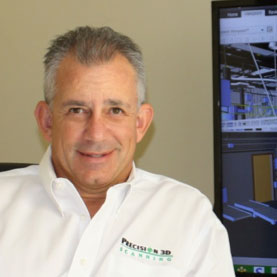by Stefan Fuchs, Institute of Robotics and Mechatronics, German Aerospace Center (DLR), Germany. Source.
Anyone working with 3D-imaging technology has figured out that customers see the most value in the identification of existing conditions. This is also known as providing “as-built services,” where you use 3D-capture technology to identify the topographic, structural, architectural, and/or MEP conditions. Regardless of the end product (whether it’s 2D or 3D) we all understand this value proposition. I mean—its measurement.
But where can 3D technology provide the maximum return?
I believe the most explosive opportunity with imaging technology remains yet untapped. Let me set this up correctly… If you’ve been involved in construction for more than 10 minutes, you already know that nothing is ever built to plan. As such, there’s an enormous need for accurate conditions to be measured continuously.
So, instead of solving the problem after it has been created, why not be proactive and use laser scanning as you construct the project, so it can be a QA/QC tool? Why not build it right the first time? Why don’t we validate and update the building information model (BIM) as the structure is being constructed?
The benefits of continuous scanning would be as follows:
- Monitoring Architects/Contractors/Engineers. Every one of these people is held accountable for their performance throughout the project. Using 3D-imaging technology while the project is in progress is an on-going truth serum—it shows everyone’s performance clearly. It also identifies errors as they occur, which forces everyone to work together more closely to fix them. It provides risk mitigation. Doesn’t that sound better than waiting until project completion and crossing your fingers?
- Reducing RFIs. A single RFI (request for information) costs between $2k-5k in extra work, not to mention a lot of lost time and pure, old-fashioned arguments. On a big project, there might be 3,000 RFIs. So not only does this increase the cost and lose profit, but it usually draws out the project timeline. Simple: Keep accurate dimensional data up to date, and you can reduce RFIs.
- Schedule compression. The overall project will speed up because there is one “playbook” that all are working from, one playbook that includes accurate data. All shareholders have the ability to understand the exact conditions of the moment and adjust, schedule, react, etc., to those conditions. The continuous scanning process is an accurate communication tool.
- Better cash flow. Many projects are paid on a performance/completion process. If you can document your performance, it removes questions marks. You can get paid sooner because there’s less room for dispute on what has been achieved.
- Up-to-date deliverables. With continuous scanning, the owner would get turnover documents that are actually representative of the completed project. This would not only allow them to better manage their facility—thereby controlling/cutting costs—but it also eliminates the need for someone to come and properly scan the structure “as-built” when renovations or changes are made. The data that was supplied is reusable for years to come.
- It works. Laser scanning really works and isn’t something that needs to be proven or is in a beta stage. It’s also extremely affordable—especially when you think about the potential risk reduction and savings in labor/materials on the project. After all, the single greatest expenses in construction are “people and parts,” regardless of what you’re building. To validate conditions as they evolve throughout the project allows you to control labor cost and material costs.
So I honestly struggle to understand why continuous, regular laser scanning is not used on every project. However, I do believe this is only a temporary situation and as owners—who ultimately fund the projects—realize the accountability they can embed into their projects, we’ll see the market evolve into a ‘built it right the first time’ process. There’s simply too much to gain.






